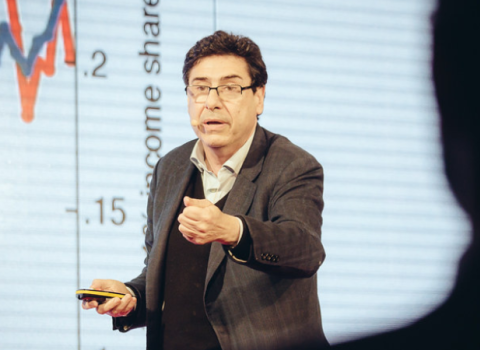EU research chief is urging grantees to use the newly created ‘Open Research Europe.’ But there are doubts about the open review method and moving to a system that excludes non-EU grant winners

The European Commission’s scientific publishing service has launched a new venue for EU research grantees to publish free-to-read results.
The Open Research Europe platform promises beneficiaries an “easy, high quality peer-reviewed” system at “no cost to them”.
The twist: authors, not editors, choose what they wish to publish – without the delay involved in traditional science publishing, the commission says.
The platform, set up to speed the flow of scientific information generated from its seven-year, €85 billion Horizon Europe programme, will post original publications in all fields of science in advance of peer review. Only after the articles are on the platform will the “transparent, invited and open peer review” begin. The names of the reviewers will be open, as well as their reviews.
The London-based open science publisher F1000 Research will run the system, with the commission picking up the tab for article processing charges.
With this model, the commission is playing catch up with some early-adopters. In 2016, Wellcome Trust, the largest charitable funder of biomedical research in Europe, contracted F1000Research to manage its open access publishing platform, Wellcome Open Research. Since then, many other major funders and institutions, including the Bill & Melinda Gates Foundation, have contracted F1000 to set up similar platforms.
In a letter last week to Horizon grantees, the commission’s research and innovation director-general Jean-Eric Paquet says, “Your involvement is key to making this initiative a success.” The formal launch of the platform will be early 2021, but submissions will start in a few weeks, the commission said.
Reaction to the new site is mixed, with some researchers highlighting the flaws of the open review method.
“It’s a great new format, [particularly] for social science and humanities folk,” tweeted Patrick Dunleavy, emeritus professor of political science and public policy at the London School of Economics.
Yet the value of the new service was not immediately obvious to all researchers. Anna Olsson, researcher and coordinator of the Laboratory Animal Science group at the Institute for Molecular and Cell Biology in Porto, said she’d have enthusiasm for the site if it came with “a statement confirming that publishing [here] would be valued in all grant evaluations by the commission and national agencies in EU member states. Unfortunately, it doesn't,” she said.
Supporters of open peer review say it pushes researchers to overcome the 'file drawer problem' and publish negative or non-confirmatory results. Most null results don’t see the light of day. By contrast, researchers are much more likely to write up studies with statistically strong results.
Others find that the open method can produce unwanted results. “From my own editorial experience, junior scholars, typically post-docs, write the best reviews: they have both time and ambition to do work properly and are often more aware of the new developments than seniors,” said Jani Erola, professor of sociology at the University of Turku.
In that stage of their careers, researchers are very cautious and keen to avoid confrontation with big names or with anyone that could have an impact on the future careers, Erola said. “Those critical reviews will probably be much less critical than they would be in anonymous form, or may avoid criticism altogether,” he said. It pays a junior researcher to be “as positive as possible” when reviewing big name papers, he said.
Stefanie Walter, professor for international relations and political economy at the University of Zurich, said she was “very sceptical” of the new arrangement. “Establishing new journals from scratch that are not available to all scholars? Sceptical this will fly,” Walter said.
Restricting the system to Horizon grantees is “perhaps not fair, but [it] will ensure some quality and distinguish it from an average depository,” said Hylke Dijkstra, a European Research Council grant holder at Maastricht University.
‘Ferrari open access’
In a separate development, academic publisher Springer Nature has announced it will be introducing an open access option from January 2021.
The publisher will charge up to €9,500 for published papers. In a separate, lower-cost trial scheme, authors will be charged a non-refundable sum of €2,190 for submissions and editorial screening to select journals within the Nature family. If a submission passes the initial editorial screen, and authors choose to go ahead and publish, they will be asked to pay top-up fees up to €4,790.
Springer Nature defended its author fee, thought to be the highest of any open access journal, as necessary to cover the cost of the full-time editors who have to trawl through large numbers of submissions to its prominent Nature title and its 32 other primary research journals.
The move coincides with the start date for Plan S, the mainly European initiative that forbids grantees of signed-up funders from placing their research in journals that publish only pay-walled articles.
Plan S grew out of concerns that commercial publishers have made excessive profits from scientific research originally funded by public money. Most commercial publishers have paywalls erected around the journals they publish, which in effect means public and charitable bodies have to buy access to the outputs of research projects that would not have gone ahead without their grant money.
Nature’s new review costs have raised eyebrows and even stirred anger among researchers.
This is the “Ferrari version of open access,” tweeted Jochen Markard, a senior researcher and lecturer for sustainability and technology at ETH Zurich in Switzerland.
Some panned the move, suggesting it only benefited wealthy institutions while locking out those that can’t afford such fees.
“RIP ambitious research in [the] Global South,” tweeted Zahar Koretsky, a PhD candidate in science, technology and society studies at Maastricht University.
Editor's note: This article was updated on December 30 to clarify details of the Nature Springer open access offer





 A unique international forum for public research organisations and companies to connect their external engagement with strategic interests around their R&D system.
A unique international forum for public research organisations and companies to connect their external engagement with strategic interests around their R&D system.